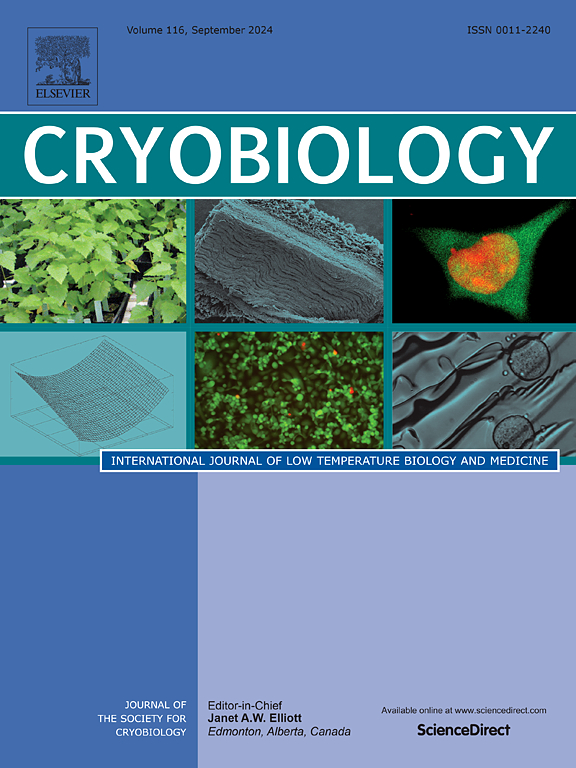细胞外低温保护剂与二甲基亚砜在保护北方虎猫成纤维细胞方面没有协同作用。
IF 2.1
3区 生物学
Q2 BIOLOGY
引用次数: 0
摘要
体细胞冷冻库的成功取决于建立可重复的冷冻保存方法。我们认为,与单独使用二甲基亚砜(Me2SO)相比,将细胞外冷冻保护剂(蔗糖和L-脯氨酸)与2.5%或10%的二甲基亚砜(Me2SO)混合使用可确保北方虎猫细胞解冻后的质量更佳。因此,我们评估了蔗糖或L-脯氨酸与2.5%或10%的Me2SO对北方虎猫成纤维细胞冷冻保存的影响。体细胞也只用2.5%或10%的Me2SO进行冷冻保存。对所有细胞的形态、膜完整性、增殖活性、新陈代谢、凋亡分类、活性氧(ROS)水平和线粒体膜电位(ΔΨm)进行了分析。无论使用哪种低温保护液,低温保存都不会影响形态、培养后膜的完整性、增殖活性和新陈代谢(P > 0.05)。然而,解冻后,与其他低温保存组相比,2.5% Me2SO 与 L-脯氨酸和 10%Me2SO能促进更高的膜完整性(P < 0.05)。有趣的是,用 10%Me2SO冷冻保存的细胞与非冷冻保存的细胞保持了相似的 ROS 水平(P > 0.05)。然而,与非冷冻保存组相比,使用含 L-脯氨酸的 10%Me2SO冷冻保存时,通过细胞凋亡分类评估的存活细胞百分比降低了(P < 0.05)。此外,所有低温保存组的ΔΨm都发生了变化(P < 0.05)。总之,蔗糖和L-脯氨酸在2.5%或10% Me2SO存在下对北方虎猫成纤维细胞的冷冻保存效果较差。此外,10%的Me2SO似乎是最适合形成该物种冷冻库的冷冻保护剂。本文章由计算机程序翻译,如有差异,请以英文原文为准。
No synergistic effect of extracellular cryoprotectants with dimethyl sulfoxide in the conservation of northern tiger cat fibroblasts
The success of somatic cell cryobanks is dependent on establishing reproducible cryopreservation methodologies. We supposed that associated extracellular cryoprotectants (sucrose and L-proline) with 2.5 or 10 % dimethyl sulfoxide (Me2SO) could guarantee better northern tiger cat cells quality rates after thawing when compared to Me2SO alone. Therefore, we evaluated the effects of sucrose or L-proline with 2.5 or 10 % Me2SO on the cryopreservation of northern tiger cat fibroblasts. Somatic cells were also cryopreserved with 2.5 % or 10 % Me2SO alone. All cells were analyzed for morphology, membrane integrity, proliferative activity, metabolism, apoptosis classification, reactive oxygen species (ROS) levels, and mitochondrial membrane potential (ΔΨm). Regardless of the cryoprotective solution, cryopreservation did not affect morphology, membrane integrity after culture, proliferative activity, and metabolism (P > 0.05). However, immediately after thawing, 2.5 % Me2SO with L-proline and 10 % Me2SO promoted higher rates of membrane integrity when compared to the other cryopreserved groups (P < 0.05). Interestingly, cells cryopreserved with 10 % Me2SO maintained ROS levels similar to non-cryopreserved cells (P > 0.05). However, the percentage of viable cells evaluated by apoptosis classification was reduced when using 10 % Me2SO with L-proline compared to non-cryopreserved groups (P < 0.05). Additionally, ΔΨm was altered in all cryopreserved groups (P < 0.05). In summary, sucrose and L-proline were less effective in cryopreservation of northern tiger cat fibroblasts in the presence of 2.5 % or 10 % Me2SO. Also, 10 % Me2SO appears to be the most suitable cryoprotectant for the formation of cryobanks of this species.
求助全文
通过发布文献求助,成功后即可免费获取论文全文。
去求助
来源期刊

Cryobiology
生物-生理学
CiteScore
5.40
自引率
7.40%
发文量
71
审稿时长
56 days
期刊介绍:
Cryobiology: International Journal of Low Temperature Biology and Medicine publishes research articles on all aspects of low temperature biology and medicine.
Research Areas include:
• Cryoprotective additives and their pharmacological actions
• Cryosurgery
• Freeze-drying
• Freezing
• Frost hardiness in plants
• Hibernation
• Hypothermia
• Medical applications of reduced temperature
• Perfusion of organs
• All pertinent methodologies
Cryobiology is the official journal of the Society for Cryobiology.
 求助内容:
求助内容: 应助结果提醒方式:
应助结果提醒方式:


